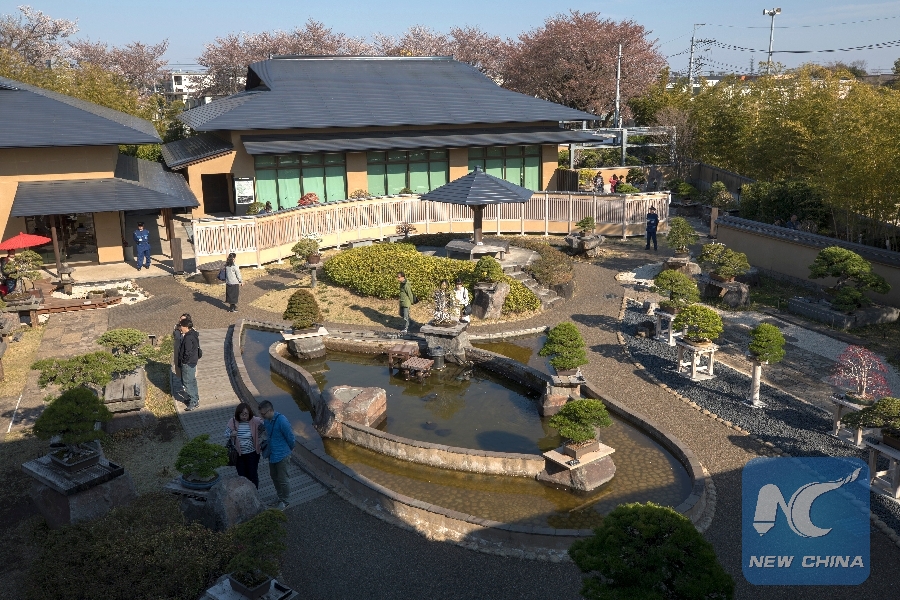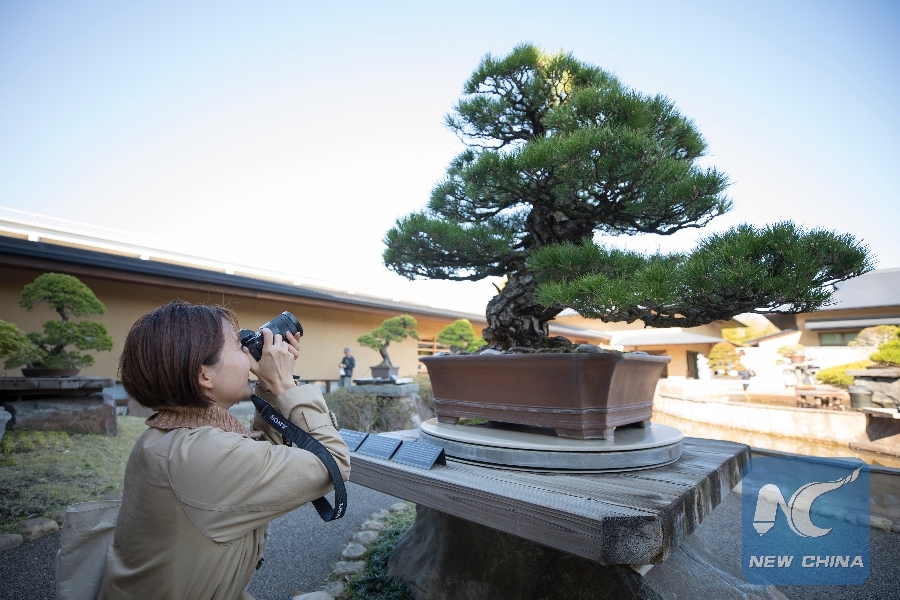
Photo taken on April 13, 2019 show the Omiya Bonsai Art Museum in Saitama, Japan, on April 13, 2019. (Xinhua/Du Xiaoyi)
TOKYO, May 8 (Xinhua) -- "Imagine yourself as a little bug standing under enormous tress when appreciating the beauty of a bonsai," said Hiroyuki Aoki, a Japanese bonsai artist, when describing his unique experience with the tree planting art.
"Integrate yourself into the pot plant. You are standing at the roots of the trunk and looking up to take in all the beautiful scenery provided by mother nature," said Aoki, also managing director of the Omiya Bonsai Art Museum in Japan's Saitama Prefecture near Tokyo.
In his mind, bonsai, an Asian art form to grow small trees in containers that mimic the shape and scale of full-size trees, possesses exceptional esthetic values and it is his hope to promote the art form worldwide.
According to Aoki, the earliest history of bonsai can be traced back to a mural found in China's Shaanxi Province from 1,300 years ago. In the painting, a man in a long line was holding a shallow pot with red and blue flowing plants in his hands.
"Our museum does not close on weekends but on Thursdays. Do you know why?" Aoki asked Xinhua reporters during the interview.
He explained that Mokuyoubi, the Japanese word for Thursday, contains the Chinese character meaning wood or trees, which echoes the theme of bonsai here and adds a humorous touch.
In the bonsai garden of the museum, there are around 60 bonsai trees on display, where they can be appreciated throughout all seasons. Some bonsai can be viewed from all angles so that visitors can enjoy different views with distinct charms.

A visitor takes pictures of a bonsai displayed at the Omiya Bonsai Art Museum in Saitama, Japan, on April 13, 2019. (Xinhua/Du Xiaoyi)
One of the largest bonsais in the museum's collection, a Japanese five needle pine called Chiyo-no-matsu, is placed on a large turntable allowing all parts of it to receive sunlight.
With a height of over 1.6 meters and a width of more than 1.8 meters, Chiyo-no-matsu, which means a pine tree over a thousand years old, is one of the largest bonsais in the museum.
Dauntlessly clinging to the earth, its twisting trunk climbs upward while its branches spread along the horizon, giving viewers an overwhelming feeling of vastness.
Many of the bonsai pieces were once owned by famous collectors including politicians and academics, according to Aoki. Many are over 100 years old, and have been given elegant titles.
Another Japanese five needle pine in the museum is named Shiraito-no-taki, or Waterfall of white threads. Its branches grow downward as if a river formed by bundles of white branches flows down.
"Viewers are reminded of water splashing and ripples on the river surface by the needle leaf at the ends of each branch," Aoki said.
Bonsai trees with eye-catching colors other than green also wow visitors with exceptional beauty.
The charm of deciduous trees such as Japanese maple is that they offer visitors the pleasure of different views each season. The appearance of the same tree in four seasons are distinctly different.
"In spring, we can enjoy the anticipation for new sprouts, and in early summer the heavenly fresh green. In autumn, their tinted leaves captivate our eyes, and in winter their bare branches gently comfort our minds," according to the brochure explaining how to appreciate bonsai art.
Each bonsai has been carefully cultivated and preserved through generations to this day. Techniques including watering, pruning, wiring and repotting are often used to nurture bonsai into a beautiful shape, which is the result of interaction between art and design from the grower and the life of the tree, Aoki explained.
He said that bonsai artists can get epiphanies at any time. Sometimes after a day's hard work, the grower gets new inspirations when going to bed or even in a dream, he said.
From a few minutes walk from the museum, the Omiya Bonsai village consisting of five bonsai gardens welcomes guests from all over the world with bonsai products. Japanese bonsai gardeners have begun to live and cultivate plants here as early as 1923 when a group of them immigrated to the area in search of land suitable for growing bonsai.
According to Aoki, the museum and the village have opened the Saitama International Bonsai Academy to promote teaching of bonsai art. The academy offers international visitors' courses, hands-on experience class for beginners, and various bonsai classes for enthusiasts.
As the International Horticultural Exhibition is being held in Beijing, China, this year, Aoki said that a promotional video from his museum was sent to be played at the Japanese pavilion. He said that he sincerely hopes such events will strengthen horticultural exchanges not only between Japan and China, but around the world as well.

